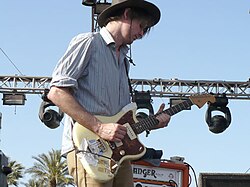Indie rock
Indie rock is a subgenre of alternative rock music which originated in the United Kingdom and North America in the early 1980s. Initially a form of independent music, it was based on small labels with low budgets which produced lo-fi rock records. Indie rock, as a genre, is very diverse; indie rock has several subgenres, and each vary greatly in style. Nevertheless, indie rock distinguishes itself from indie pop as it is generally rougher and more hard-edged.
| Indie rock | |
|---|---|
| Stylistic origins |
|
| Cultural origins | Early 1980s, the United Kingdom and North America |
| Typical instruments | |
| Subgenres | |
| |
| Other topics | |
| |
Indie rock and alternative rock are often used interchangeably.[1] Nevertheless, there are some differences between the genres. Initially, the term "indie" was used for British-based music, whilst "alternative" for American.[1] In 1986, British magazine NME released a cassette, C86, which defined much of the sound of what is today regarded as "indie" music,[1] notably the usage of jangly guitar sounds, retro elements borrowing from 1960s rock bands, and a DIY, amateur-like sound.[1]
According to About.com, the term indie has two different general meanings in the UK and North America. In the UK, "indie" is a term used to describe "melancholy" and "non-rock" ballad-based music;[1] in North America, on the other hand, "indie" is often used to refer to retro-sounding, "twee" and "Anglophilic" music.[1]
Today, indie rock has been able to find some commercial success. Popular indie rock acts and artists include R.E.M., Pavement, Regina Spektor and Superchunk, to name a few.
Additionally, indie rock has fused to create several new genres and subgenres. Indietronica, or indie electronic music, is a genre which fuses elements of indie rock, pop and electronic music, and often makes usage of synthesizers and drum machines. Alternative dance music, or indie dance, is also a genre which fuses elements of electronic dance music, alternative rock, indie rock and new wave, usually incorporating elements of the rock genres and using them in a dance-based context.
Indie Rock Media
The Velvet Underground was an influential experimental rock act during the late 1960s.
Dan Treacy's Television Personalities, one of the leading bands of the UK DIY wave and forerunners to indie pop
The Chills performing at Indietracks in rural Derbyshire in 2014
British band the Jesus and Mary Chain performing in California in 2007
My Bloody Valentine pioneered the indie rock subgenre shoegaze.
The Stone Roses' 1990 Spike Island concert was the highest attendance performance by an independent artist of its time.
The success of grunge allowed Sonic Youth to breakthrough into the mainstream.
Pavement singer/guitarist Stephen Malkmus
The Strokes are one of the most influential bands to indie rock in the 2000s.
References
- ↑ 1.0 1.1 1.2 1.3 1.4 1.5 Anthony Carew. "Difference Between Alternative and Indie Music". About.com Entertainment. Archived from the original on 11 May 2013. Retrieved 23 July 2015.








